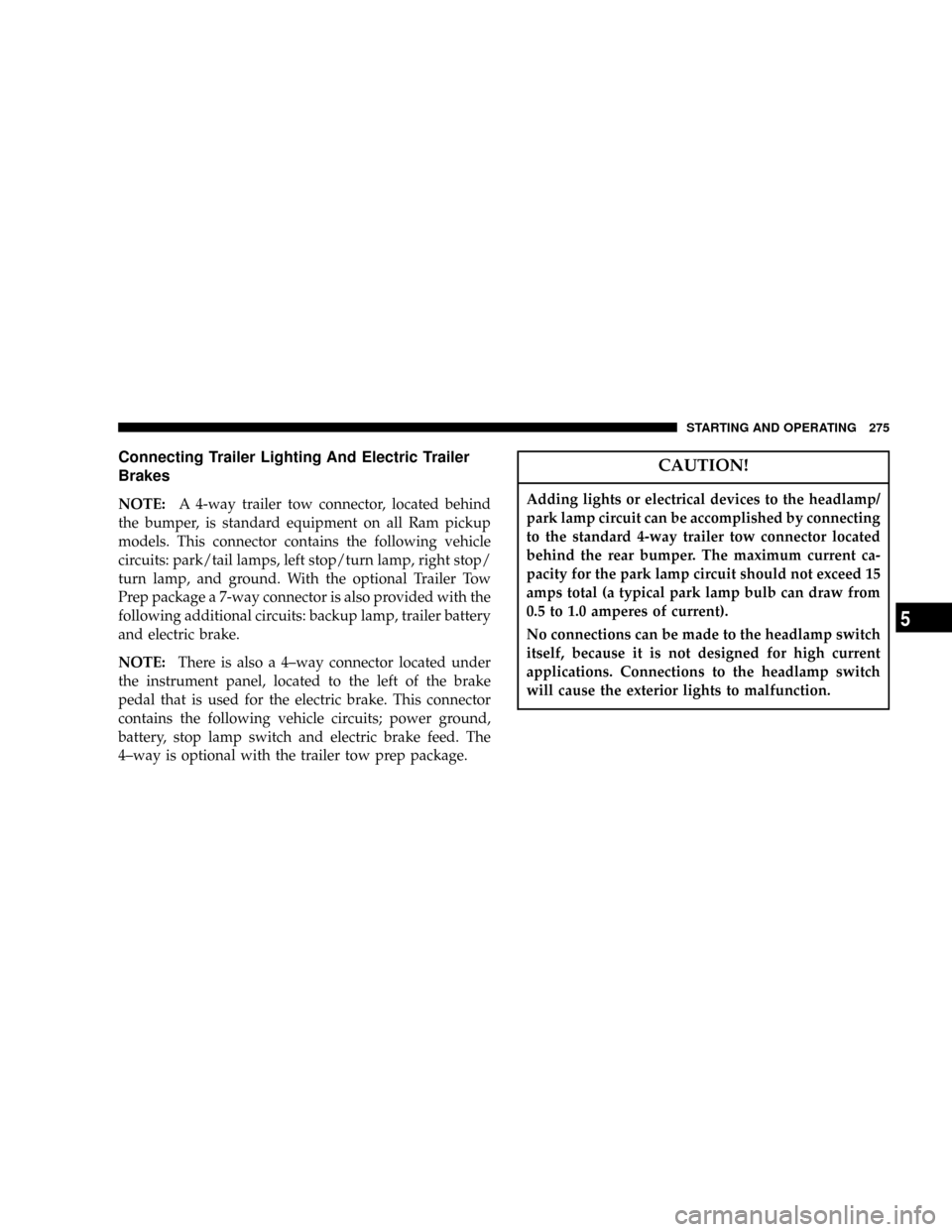Page 196 of 429

edges of the instrument panel. The demisters also pro-
vide extra air ducts for circulation. They are in operation
whenever the Floor, Mix or Defrost modes are in use.
NOTE:When you turn off the engine you may hear a
hissing sound from under the hood for a short period of
time. This is a normal condition that occurs if the air
conditioning system has been on. It is not an indication of
a problem with the air conditioning system.
Operating Tips
Fast Cooldown
For a fast cooldown, turn the blower fan rotary knob to
the extreme right position, turn the mode control to the
panel fresh position, press the snowflake button to turn
on the air conditioning, and drive with the windows
open for the first few minutes. Once the hot air has been
expelled, close the windows and press the Recirculation
pushbutton. When a comfortable condition has beenreached, choose a mode position and adjust the tempera-
ture control slide and blower speed as necessary to
maintain comfort. For high humidity conditions it may
be necessary to remain in the Recirculation mode to
maintain comfort.
Window Fogging
Windows will fog on the inside when the humidity inside
the vehicle is high. This often occurs in mild or cool
temperatures when it's rainy or humid. In most cases
turning on the Air-conditioning (pressing the snowflake
button) will clear the fog. Adjust the temperature control,
air direction and blower speed to maintain comfort.
As the temperature gets colder it may be necessary to
direct air onto the windshield by using MIX Mode
position on the control. Adjust the temperature control
and blower speed to maintain comfort. Higher blower
196 UNDERSTANDING YOUR INSTRUMENT PANEL
Page 197 of 429

speeds will reduce fogging. Interior fogging on the
windshield can be quickly removed by selecting the
defrost mode.
Regular cleaning of the inside of the windows with a
non-filming cleaning solution (vinegar and water works
very well) will help prevent contaminates (cigarette
smoke, perfumes, etc.) from sticking to the windows.
Contaminates increase the rate of window fogging.
Summer Operation
Air conditioned vehicles must be protected with a high
quality antifreeze coolant during summer to provide
proper corrosion protection and to raise the boiling point
of the coolant for protection against overheating. A 50 %
concentration is recommended. Refer to Recommended
Fluids and Genuine Parts for the proper coolant type.
When using the air conditioner in extremely heavy traffic
in hot weather especially when towing a trailer, addi-
tional engine cooling may be required. If this situation isencountered, operate the transmission in a lower gear to
increase engine RPM, coolant flow and fan speed. When
stopped in heavy traffic, it may be necessary to shift into
NEUTRAL and depress the accelerator slightly for fast
idle operation to increase coolant flow and fan speed.
NOTE:On models equipped with Diesel engines, the
idle speed will automatically increase to 1000 rpm at
elevated coolant temperatures to improve engine cooling.
Your air conditioning system is also equipped with an
automatic recirculation system. When the system senses
a heavy load or high heat conditions, it may use partial
Recirculation A/C mode to provide additional comfort.
Winter Operation
When operating the system during the winter months,
make sure the air intake, located directly in front of the
windshield, is free of ice, slush, snow, or other obstruc-
tions.
UNDERSTANDING YOUR INSTRUMENT PANEL 197
4
Page 198 of 429
Operating Tips Chart
198 UNDERSTANDING YOUR INSTRUMENT PANEL
Page 208 of 429

CAUTION!
Long periods of engine idling, especially at high
engine speeds can cause excessive exhaust tempera-
tures which can damage your vehicle. Do not leave
your vehicle unattended with the engine running.
WARNING!
Do not leave children or animals inside parked
vehicles in hot weather. Interior heat build up may
cause serious injury or death.
TRANSMISSION SHIFTING
Automatic Transmission with Overdrive
The gear shift selector display, located in the instrument
panel cluster, indicates the transmission gear range (the
selector is illuminated for night driving). The selector
lever is mounted on the right side of the steering column.
You must depress the brake pedal, to pull the selector
lever out of park (P) position (Brake Interlock System). To
drive, move the selector lever from Park or Neutral to the
desired drive position. Pull the selector lever toward you
when shifting into Reverse, Second, First or Park, or
when shifting out of Park.
Gear Ranges
DO NOT race the engine when shifting from Park or
Neutral position into another gear range.
ªPº Park
This gear position supplements the parking brake by
locking the transmission. The engine can be started in
208 STARTING AND OPERATING
Page 221 of 429

Electronically Shifted Transfer Case Operating
Information/Precautions
This is an electric shift transfer case and is operated by
the 4WD Control Switch (Transfer Case Switch), which is
located on the instrument panel.
The Electronically Shifted transfer case provides 4 mode
positions: 2 (rear) wheel drive high range or all wheel
drive high range, 4 wheel drive high range, 4 wheel drive
low range, and neutral.
The Electronically Shifted transfer case is designed to be
driven in the 2 wheel drive position (2WD) or all wheel
drive position (AWD) for normal street and highway
conditions (dry hard surfaced roads).
When additional traction is required, the transfer case
4HI and 4LO positions can be used to lock the front andrear driveshafts together and force the front and rear
wheels to rotate at the same speed. This is accomplished
by rotating the 4WD Control Switch to the desired
position - see Shifting Procedure section for specific
shifting instructions. The 4HI and 4LO positions are
designed for loose, slippery road surfaces only. Driving
in the 4HI and 4LO positions on dry hard surfaced roads
may cause increased tire wear and damage to the driv-
eline components.
NOTE:The transfer case Neutral (N) position is selected
by depressing the recessed button located on the lower
left hand corner of the 4WD Control Switch. The transfer
case Neutral (N) position is to be used for recreational
towing only. See the Recreational Towing section for
specific procedures on shifting into and out of Neutral
(N).
STARTING AND OPERATING 221
5
Page 229 of 429
PARKING BRAKE
The foot operated parking brake is positioned below the
lower left corner of the instrument panel. To release the
parking brake, pull the parking brake release handle.
NOTE:The instrument cluster red brake warning light
will come on and flash to indicate that the parking brake
is applied. You must be sure that the parking brake is
fully applied before leaving the vehicle.
Be sure the parking brake is firmly set when parked and
the gear shift lever is in the PARK position. When
parking on a hill you should apply the parking brake
before placing the gear shift lever in PARK, otherwise the
load on the transmission locking mechanism may make it
difficult to move the selector out of PARK.
STARTING AND OPERATING 229
5
Page 275 of 429

Connecting Trailer Lighting And Electric Trailer
Brakes
NOTE:A 4-way trailer tow connector, located behind
the bumper, is standard equipment on all Ram pickup
models. This connector contains the following vehicle
circuits: park/tail lamps, left stop/turn lamp, right stop/
turn lamp, and ground. With the optional Trailer Tow
Prep package a 7-way connector is also provided with the
following additional circuits: backup lamp, trailer battery
and electric brake.
NOTE:There is also a 4±way connector located under
the instrument panel, located to the left of the brake
pedal that is used for the electric brake. This connector
contains the following vehicle circuits; power ground,
battery, stop lamp switch and electric brake feed. The
4±way is optional with the trailer tow prep package.
CAUTION!
Adding lights or electrical devices to the headlamp/
park lamp circuit can be accomplished by connecting
to the standard 4-way trailer tow connector located
behind the rear bumper. The maximum current ca-
pacity for the park lamp circuit should not exceed 15
amps total (a typical park lamp bulb can draw from
0.5 to 1.0 amperes of current).
No connections can be made to the headlamp switch
itself, because it is not designed for high current
applications. Connections to the headlamp switch
will cause the exterior lights to malfunction.
STARTING AND OPERATING 275
5
Page 420 of 429

Hub Caps............................. 308
Ignition.............................14,204
Key ............................... 11,14
Lock................................ 14
Infant Restraint........................55,56
Inflation Pressure Tires.................... 251
Inside Rearview Mirror.................... 75
Instrument Cluster....................142,143
Instrument Panel and Controls.............. 141
Instrument Panel Lens Cleaning............. 364
Interior Appearance Care.................. 363
Intermittent Wipers...................... 105
Introduction............................. 4
Jack Location........................... 296
Jack Operation.......................... 302
Jump Starting.......................... 312Key, Replacement........................ 12
Key, Sentry............................. 11
Key-In Reminder......................... 11
Keyless Entry System...................... 22
Keys................................ 11,16
Lane Change and Turn Signals.............. 103
Lap Belts.............................. 42
Lap/Shoulder Belts....................... 34
LATCH (Lower Anchors and Tether for CHildren) . 59
Lights...............................70,99
Airbag............................55,144
Anti-Lock Warning..................148,232
Battery Saver......................... 100
Brake Warning........................ 147
Bulb Replacement...................... 366
Cap Top Clearance..................... 374
Center Mounted Stop................... 372
Check Engine......................... 143
420 INDEX